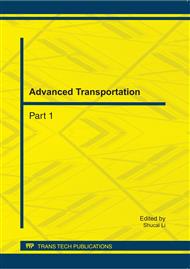p.340
p.347
p.352
p.360
p.367
p.373
p.378
p.382
p.386
Study on Properties and Pavement Performance of Anti-Flaming and Warm-Mix SBS Modified Asphalt
Abstract:
In order to solve problems such as environmental contamination, large resource consuming, and the inflammability of present asphalt mixture, a warm-mix agent was chosen and fire retardant was added to asphalt to modify its characteristics. The anti-flaming and warm-mix asphalt has been produced in the orthogonal experiment, and its road property and anti-flaming property lived up to expectation. The experiment shows that under the condition of a lower temperature (15-20°C lower than the the mix temperature), the rutting resistance of the anti-flaming and warm-mix SBS modified asphalt , but its low temperature property and water sensitivity decreased. This asphalt has excellent anti-flaming characteristic, and thus it can decrease the property loss in case of fire.
Info:
Periodical:
Pages:
367-372
Citation:
Online since:
September 2011
Authors:
Keywords:
Price:
Сopyright:
© 2011 Trans Tech Publications Ltd. All Rights Reserved
Share:
Citation:


